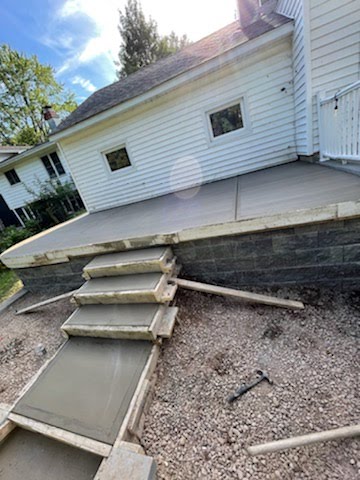Can Concrete Steps Be Resurfaced?Concrete surfaces require constant maintenance and upkeep. From cracks due to age to water damage, it can be very expensive to fix them properly. The good thing is, that there are ways to resurface unsightly concrete steps to make them look great again, whether it involves using cement, brush, concrete overlay, or polymer modifiers. A number of methods exist for resurfacing concrete steps. These include techniques like epoxy coatings, plastic overlays, and even new concrete construction. We'll review each step and explain exactly what happens when taking it apart and putting it back together. Most homeowners want to re-use their old concrete steps, but they don't realize that their old step risers might become dangerous hazards. Is resurfacing concrete a good idea?The answer depends on the condition of your existing concrete steps. If you have cracked or loose concrete steps, then resurfacing may be an excellent option. However, if your concrete steps are in decent shape, then resurfacing will likely not be necessary. In this case, we recommend replacing your existing concrete steps with brand new ones from our selection of precast concrete stairways that are available in a wide variety of colors. Step Risers Are Dangerous Hazards Concrete steps are often used as walkways to get from one level to another. When these steps are damaged due to heavy foot traffic, they pose a serious hazard. People walking on them can slip and fall if they aren't repaired correctly. This could result in severe injury or death. The Problem With Epoxy Coatings Epoxy coatings are a popular way to resurface concrete steps and hiding surface imperfections. They usually consist of two parts: a resin and a hardener. The problem is that the resin is toxic and may cause skin irritation. In addition, the hardened resin dries out quickly so it needs to be reapplied frequently. This makes the whole project more difficult than it really needs to be. Plastic Overlays Plastic overlays are another option for resurfacing concrete steps, but they also have drawbacks. First off, they're not permanent. They can chip and peel away or reveal minor cracks over time. Second, they're flimsy and won't last long. Finally, they're not easy to apply. This means that you'll have to spend extra money to rent or buy special equipment just to broaden tour repair options. New Construction Another method of resurfacing concrete steps involves using new concrete instead of repairing existing ones. This is a better solution because it doesn't involve any chemicals at all. However, it does mean that you'll have to tear down your current steps and rebuild them from scratch. That's going to result in spending quite a bit of money due to labor costs. Color Application for your Concrete SurfaceIf you decide to resurface your concrete steps, you should consider applying colors or patterns to the surface. This will give your steps a fresh appearance while still maintaining their structural integrity. You can choose from a wide range of colors such as red, green, blue, yellow, black, white, etc. A painting project for concrete steps resurfacing isn't always a bad idea. It depends on how much work you need to do to make your steps safe and beautiful again. If you have cracks or other problems on the solid base, then a concrete resurfacer may help. But if your steps look fine, then resurfacing probably isn't worth the trouble. How Change in Temperatures Affect Unsound ConcreteHave you ever wondered why concrete steps seem to get darker after rain? There are several possible reasons for this occurrence based on the current temperature, but they tend to fall into two categories: weather-related or surface related. 1) Standing water seeps through the expansion joints between the individual blocks of concrete. 2) Moisture collects under the treads of your stairs. 3) Water enters the pores of the concrete itself. Weather conditions affect the amount of moisture that gets absorbed by the concrete. The sun heats up the concrete and causes it to expand. As the concrete expands, air pockets from inside the structure. Air pockets allow warm water to enter the concrete and greatly impact its strength. The weight of people standing on the steps creates pressure against the concrete. As a result, the concrete begins to crack. The weight of the people standing on the steps causes the concrete to shift. This movement weakens the bond between the concrete and its surrounding mortar. When the cement in the mortar starts to dry out, it shrinks. This shrinkage pulls the concrete apart from the surrounding mortar. The shrinking process continues until there is no longer enough adhesion holding the concrete together. Once the mortar has dried completely, the concrete becomes brittle. This makes it easier for the concrete to have loose pieces and abandon its compressive strength. Eventually, the entire stairway collapses. To prevent this from happening, you must repair the problem before it becomes too big. In order to fix the problem, you must remove the damaged area and replace it with new concrete mix products. New concrete is stronger than old concrete. Therefore, when you install new concrete, it won't be affected by the same problems that caused the original deterioration. Once you've installed new concrete, you can paint it to match the rest of your home. An Experienced Concrete ResurfacerIf you're thinking about resurfacing your concrete steps, then you need an experienced concrete resurfacer who knows how to do the job right, has done extensive repairs, and uses quality cement products. You should never attempt this on your own because it's a complicated process and requires specialized equipment. If you try to do it yourself, you could end up with a mess that will take weeks or months to repair. It's best to hire someone who has experience in doing concrete work. They have the tools and know-how to use them safely. Concrete Repair CostsThe average cost of repairing concrete steps varies depending on the size of the project, the materials used, and the skill level of the contractor. Concrete costs can range anywhere from $1,000 to $10,000 or more, considering the additional labor cost for a complete concrete step makeover.
It's always better to get estimates before starting the job so that you can compare prices and find one that works within your budget and your concrete resurfacing idea.
2 Comments
12/19/2022 06:47:38 am
Concrete surfaces are subject to a lot of wear and tear. They require constant maintenance and upkeep to keep them looking their best. That means regular cleaning, sealing, and repairs. Left unchecked, concrete surfaces can become stained, cracked, and uneven. That not only looks bad, but it can also create trip hazards. That's why it's important to stay on top of maintenance. A little bit of work now can save you a lot of work later.
Reply
Leave a Reply. |
|

